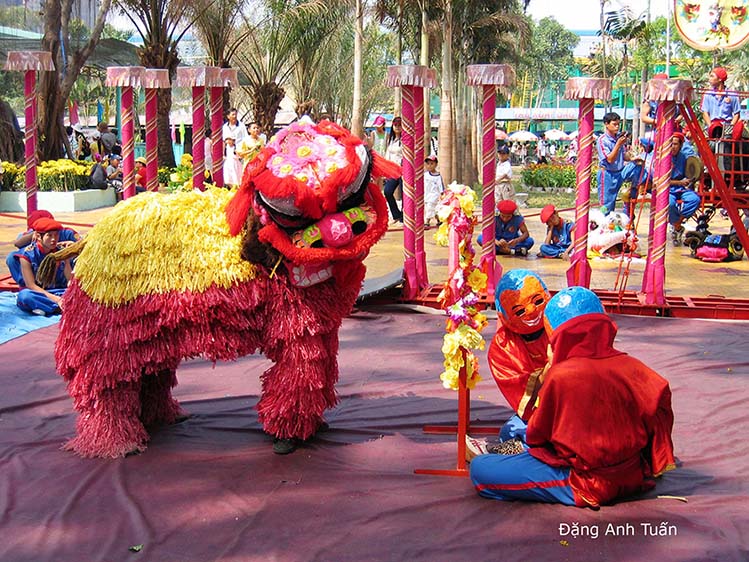For the majority of Vietnamese, Tet evokes a magic period of the year when everyone forgets his or her misfortune or misery during the previous year. It is the start of the new year in the lunar calendar. Rich or poor, young or old, everyone is going to celebrate it with solemnity and cheerfulness. It is the moment to dream and to recover hope.
It is also the period when peasants let their fields take a break while hoping to have better crops next year thanks to the renewal of nourishing nature. That is why in one of the Vietnamese folk songs, the following verses are found:
Một năm là mười hai kỳ
Em ngồi em tính có gi` chẳng ra
Tháng giêng ăn Tết ở nhà
Tháng hai rỗi rãi quay ra nuôi tầm
Twelve months make a year,
You can count them with no difficulty.
The first month, you stay home enjoying Tet,
Free the second month, you can turn raising silk worms.
It is also the festival of friendship but above all that of the cult of ancestors and genies.
According to historians, the celebration of this festival goes back to the Han Chinese domination (i.e. in the first century of Christian era). The preparation of this festival is very meticulous and requires long days in advance. Seven days before Têt, there is the farewell ceremony to the genies of the Kitchen (Ông Táo). The latter comes back to earth on the night of the thirtieth day of the twelfth month of the lunar year. In the village, in front of each house is set up a bamboo pole (or cây nêu) possibly reaching several meters.
One finds at the top of this pole offerings, votive papers and terra cotta tablets, while at its foot there is a design of a crossbow whose point is directed toward the outside. It is an old Buddhist tradition that helps prevent demons and ghosts from entering. It is also in the village that one finds again the ambiance of festival with the preparations of Tet. It is also on this occasion that the whole family is gathered from the youngest to the oldest around the cooking pot to steam cook the sweet rice cake.
It is an occasion for the head of the family to pass on to his children the tradition of the cult of ancestors and teach them the rites of the cult.
Everyone, from the youngest to the oldest takes turn to bow down before the altar, each having a moving idea about the dead and imploring their help for the realization of deep wishes. One finds on the altar during the days of Tết not only refined dishes, hand picked fruits, cakes, especially the sweet rice cake and cups of tea or water, but also branches of flowering peach tree. The latter are chosen in such a way that they bloom during the festival of Tết.
Tet is also the festival of children. They put on the most beautiful of their dresses and play together in the fireworks on the street. They receive from adults a red envelope containing a bill or a coin that would bring them luck for the whole year.
As for adults, they go in procession in pagodas and try to know their future by pulling each a divinatory stick. It is also the occasion to obey certain elementary rules that all Vietnamese must know: banning bad words, toning down all quarrels, not touching broom, avoiding to be the first to show up at someone’s house on the first day of the year.
It is also the occasion to see the unicorn dance ( Múa Lân ) or the Dragon dance. This animal whose head is magnificently decorated and whose body is carried by several dancers, waves to the rhythm of the sound of drum. It is always accompanied by another smiling and portbellied dancer wearing a saffron robe (Ông Ðịa). It is the dance-combat between men and animals, between the Good and the Evil that is always ended up with the triumph of men over animals.
The festivities of Tết last for a week or even a month in certain villages. But because of the difficulties of life, it is the habit nowadays to stop working only during the first three days of the years.
 Each year is symbolized by a cycle of 12 animals:
Each year is symbolized by a cycle of 12 animals:
Tý, Sủu, Dần, Mẹo, Thìn, Tị, Ngọ, Mùi, Thân, Dậu, Tuất , Hợi Rat, Buffalo, Tiger, Cat, Dragon, Snake, Horse, Goat, Monkey, Rooster, Dog, Pig
From his or her birth each individual possesses an astral sign which is symbolized by the symbol animal of the year of birth.
Moreover, each symbol animal is associated with one of the five celestial elements (Wu Xing)(ou Ngũ Hành in Vietnamese):
Thủy, Hỏa, Mộc, Kim, Thổ
Water, Fire, Wood, Metal and Earth.
chosen among the names of 10 heavenly stems grouped in pairs (Jia, yi, Bing, ding, Wu, ji, geng,xin, ren, gui))(or Hệ Can in vietnamese Giáp, Ất, Bính, Đinh, Mậu, Kĩ, Canh, Tân, Nhâm, Qúi): [Giáp, Ất] =Wood (Mộc), [Bính, Đinh]=Fire (Hỏa), [Mậu,Kĩ]=Earth (Thổ), [Canh, Tân]=Metal (Kim), [Nhâm,Qúi]=Water (Thủy))
That is why this year is the year of Earth Pig. It only comes back every sixty years (i.e. 1899, 1959, 2019, 2079 etc…). In the Annals of our history, there were two Tets the Vietnamese people remember for a long time: it was the Tet that allowed emperor Quang Trung to reconquer our capital Hànội in 1788 against the Qing and the Tết Mậu Thân in 1968 in South Vietnam.


